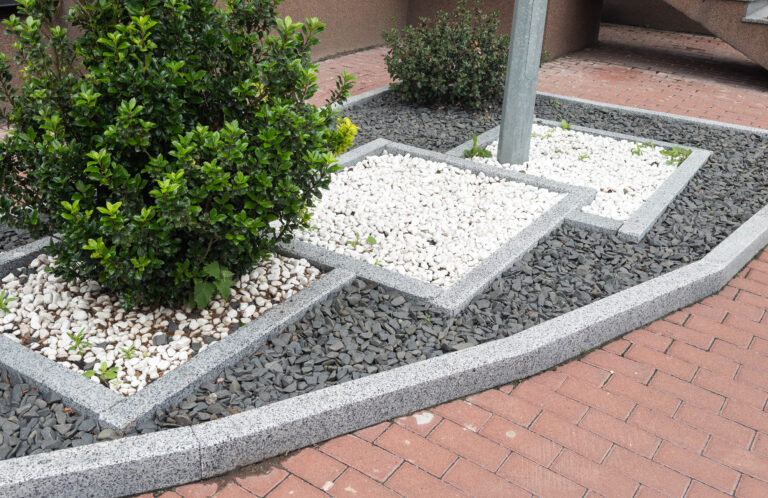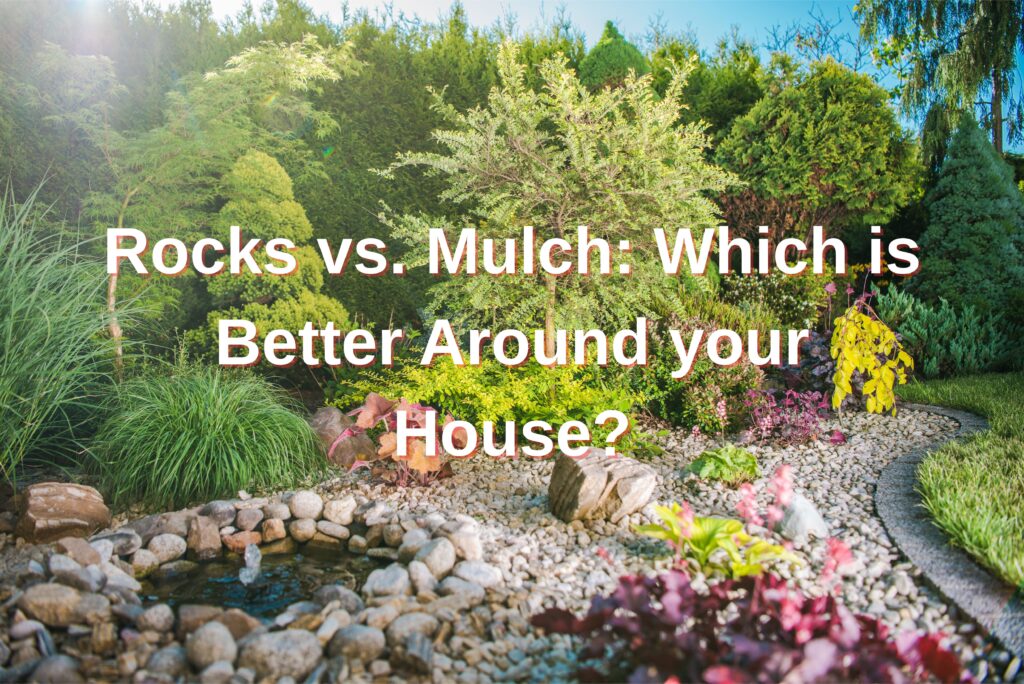Table of Contents
Introduction: Ground Cover Choices Matter More Than You Think
When you’re planning your landscape, especially around the perimeter of your home, the debate between rock vs. mulch is more than just an aesthetic choice—it’s about long-term functionality, plant health, maintenance, safety, and cost. Whether you’re a hands-on gardener or a busy homeowner looking for the lowest upkeep, your decision will directly impact curb appeal, home protection, and even utility bills.
Should you go for long-lasting stone? Or would nutrient-rich mulch serve your plants better? Let’s take a deep dive into the benefits, drawbacks, and best uses of each material to help you choose wisely.
Section 1: Rocks – A Durable, Low-Maintenance Option
What Are Landscaping Rocks?
Landscaping rocks include pea gravel, river rocks, lava rocks, crushed granite, slate chips, and more. They come in various sizes and colors, offering a decorative yet practical way to cover ground.
Advantages of Using Rocks
Exceptional Longevity: Rocks don’t decay or degrade, making them a one-time investment that can last for decades.
Low Maintenance: Unlike mulch, which needs regular refreshing, rocks hold their shape and color with minimal attention.
Pest Deterrent: Termites, ants, and rodents aren’t drawn to stone, reducing the risk of infestations near your foundation.
Fire Resistance: Non-combustible rocks make a great fire break around homes in wildfire-prone areas.
Good for Drainage: Ideal for areas with poor soil or drainage issues—rocks allow water to pass freely and reduce erosion.
Great for High-Traffic Areas: Rocks are perfect for walkways, driveways, or seating areas that need strong, stable ground cover.
Disadvantages of Using Rocks
Higher Upfront Cost: Rocks cost significantly more to purchase and install compared to mulch.
Heat Absorption: In hot climates, rocks can raise the temperature around plants, drying out soil faster and stressing roots.
Weed Infiltration: Weeds can still grow between stones over time, especially if landscape fabric wasn’t installed properly.
Hard to Remove or Redesign: Rocks are difficult and expensive to shift once installed.
No Soil Benefits: Rocks don’t improve soil quality or provide nutrients.
Section 2: Mulch – A Natural, Plant-Friendly Choice
What Is Mulch?

Advantages of Using Mulch
Enriches the Soil: As it breaks down, organic mulch improves soil structure, encourages microbial life, and adds nutrients.
Moisture Retention: Mulch dramatically reduces evaporation, keeping soil moist longer between waterings.
Temperature Regulation: It insulates the soil, protecting roots from heat in summer and frost in winter.
Weed Suppression: A thick layer of mulch keeps sunlight from reaching weed seeds, reducing growth.
Natural Appearance: Mulch gives a softer, more natural look that blends beautifully into garden beds.
Cost-Effective: Mulch is inexpensive and widely available at garden centers.
Disadvantages of Using Mulch
Needs Replacement: Organic mulch decomposes over time and usually requires annual replenishment.
Can Attract Pests: If placed too close to the home, mulch can invite termites, ants, and even rodents.
Easily Displaced: Wind and heavy rain can move mulch out of place, especially on slopes.
Potential Mold or Fungus: If not properly aerated or if applied too thick, mulch can develop mold or harbor diseases.
Flammable in Dry Conditions: Dried mulch near a structure may increase fire risk.
Section 3: Climate Considerations
Hot, Dry Climates: Rocks are preferable for xeriscaping and desert environments. They don’t decompose and won’t dry out quickly like mulch.
Cool, Moist Climates: Mulch helps protect against temperature swings and improves already-rich soil, making it the better choice.
High-Wind or Flood-Prone Areas: Rocks are heavier and less likely to wash or blow away.
Fire Zones: Use rock around the house as a fire-safe buffer. Keep mulch at least 3 feet from structures.
Timing matters—learn the best seasons to mulch your garden beds in our Previous blog When to Mulch your Garden Beds: Seasonal Guide
Section 4: Environmental Impact
Sustainable Mulch Options: Bark, leaves, and grass clippings are biodegradable and promote soil health—ideal for eco-conscious gardeners.
Eco-Friendly Rock Choices: Gravel or crushed stone may come from local quarries, but do not biodegrade or support soil life.
Recycled Materials: Consider rubber mulch (from recycled tires) or repurposed stone for environmentally sustainable choices.
Section 5: Aesthetics and Design Tips
Rocks offer a crisp, modern, or desert-like look. Use them for hard edges, accents, or Zen-style gardens.
Mulch provides a natural, earthy appearance. Ideal for flower beds, borders, and traditional landscapes.
Pro Tip: Try combining both! Use rock around permanent structures like patios or walkways, and mulch in active garden beds where plants need nourishment.

Section 6: Homeowner Decision Checklist
| Criteria | Rocks | Mulch |
|---|---|---|
| Upfront Cost | High | Low |
| Longevity | Decades | 1–2 Years |
| Soil Health | No Benefit | Improves Over Time |
| Pest Resistance | Excellent | Moderate (attracts pests) |
| Fire Resistance | Yes | No |
| Maintenance | Very Low | Seasonal Refresh Needed |
| Plant Support | Poor (dries soil) | Excellent |
| Aesthetics | Clean & Modern | Natural & Warm |
| Climate Suitability | Dry, Hot, Windy | Cool, Moist, Temperate |
| Ease of Installation | Labor Intensive | DIY Friendly |



